What is a Hospital Bed?
A hospital bed is a special bed that may be needed to care for a person who is ill. Most hospital beds look like a twin bed made from metal parts. The bed has moveable side rails. Hand cranks or electricity may be used to change positions of the bed. The bed surface, called the deck, is usually 3 separate pieces, able to move independently of each other. This allows for infinite number of positions. Some models are also able to raise and lower the entire bed deck as a single surface. Some beds are manual, operated only by hand cranks. Manual models are least expensive, and require a caregiver to be present to adjust the bed positions. Electric models have several motors to adjust the patient's position. Electric hospital beds have a wired or wireless hand control for easy operation. Some electric models can be ordered with optional Staff Controls, which are embedded into the head-board or foot-board. Staff Controls can lock out and override the hand pendant for patients with cognitive disabilities. A relative newcomer to the market is a HI-LO hospital bed. Hi-Lo beds have one or more motors to raise and lower the entire bed deck close to the floor. This greatly reduces patient injuries resulting from falling out of bed. Hi-lo beds are easily able to raise to regular height of 26" or more for daytime activities, and lower to about 7" for sleeping.
 |
 |
 |
| HD Bariatric Bed | Hi-Lo Bed | Full Electric Bed |
What type of bed is right for me?
There are different types of hospital beds for your consideration. Your caregivers as well as doctors can help you choose the right type of bed for you.
Manual Hospital Bed
This type of bed uses hand cranks to change positions. If you are unable to operate the cranks, a caregiver will need to help. The cranks are usually located at the foot of the bed, at bed deck height. Manual beds may not have as many positions as an electric bed. A manual bed may be difficult to operate for a person who has limited mobility or arm strength. The operator needs good arm and shoulder strength to turn the cranks to raise and lower the patient. Because the cranks are low to the ground, a person with a back condition or knee problems may also have trouble with operation.
Electric Hospital Bed
This type of bed is controlled by a hand pendant. An electric bed has two, three or four motors to independently raise and lower sections of the bed. This type of bed needs to be plugged into an electrical outlet, and users typically have a back-up battery connected in case of a power outage. Hand controller has large buttons with pictures to make operating the bed easy. Some electric hospital beds can be ordered with Staff Control embedded into the foot-board. This makes it easy for caregivers to manipulate the bed, and to lock out patient's controller, if required. A Semi-Electirc Hospital Bed uses a combination of motors and hand-cranks to operate the lifting mechanism.
HI-LO Bed
Hi-low beds are like normal electric hospital beds, with additional function. The entire bed surface is able to move up and down, as well as change positions. This type of bed is most useful for patients who may fall out of bed. In it's lowest position, the hi-lo bed is only several inches off the ground, which helps prevent injury resulting from patient falls.
An adjustable bed, like Flex-a-Bed is made for patients with or without a medical condition. Adjustable beds are made by manufacturers who also make regular beds and bed frames. These beds are avaialbe with motorozied upper body and lower body sections, as well as Hi-Lo functions. Adjustable beds are usually not covered by Medicare or supplemental insurance. Flex-a-bed beds are designed to look like a standard Full, Queen or King bed frames and fit into most home's decor with ease.
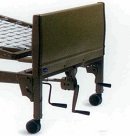 |
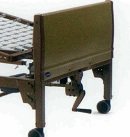 |
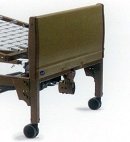 |
 |
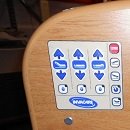 |
| Manual Crank Hospital Bed | Semi Electric Hospital Bed | Full Electric Hospital Bed | Hi Lo Full Electric Hospital Bed | Bed Staff Control |
What kind of mattress is best for me?
There are may types of mattresses available for a hospital bed. Most common types are: innerspring mattress, fiber-fill mattress and foam mattress . There are also therapeutic gel overlays to help relive pressure points on the body. Innerspring and fiber-fill are least expensive, and most Medicare approved hospital beds come with this types of mattress. Foam mattresses are usually more expensive, and are available to fit specific needs. A Standard foam mattress is usually more comfortable for the patient, as it is able to conform to the body's shape. There are also Level II and Level III support foam mattresses. These are made from different types of foam material pieced together to help prevent bed sores and skin breakdowns. Foam mattresses eliminate pressure hot-spots and are usually more comfortable for the patient.
 |
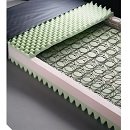 |
| Foam Mattress | Innerspring Mattress |
What about side-rails?
Side-rails are optional parts of the hospital bed. They offer several advantages for the patient and caregiver:
- Prevent falls out of bed
- Provide a place to hold when getting in and out of bed
- Help with turning or repositioning
- Provides a place to fasten hand controller. Offers more storage space with optional hang-on storage pouch
There are also considerations when using side-rails. A patient's body part may get trapped between the rails. Consider various designs to minimize entrapment. When using full-length side-rails, a patient may attempt to climb over the rail and fall. Because of extra height, there is a greater risk of injury than falling out of bed itself. Half-length rails offer the best compromise for most patients. They offer extra support during repositioning and getting in and out of bed, as well as reducing the risk of falling out of bed.
An optional accessory most users purchase is an Overbed Table. This table has an height-adjustable base and four wheels to slide easily under the bed. Some are able to pivot to make it easy to read books or use a tablet or a laptop computer.






